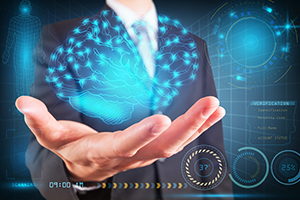Get to know your digital twin: the next generation of IoT

Imagine if you could have a digital twin of your business or product that fits in your pocket? A simulation so accurate, so perfect in it’s design down to the last detail, that anything you changed in your virtual world would be exactly the same as if you had done so in real life.
Forget ones and zeros, we’re talking about a fully immersive digital duplicate, so that your organization could actually see the live impact of an innovation or system change before investing a single cent.Â
Â
OK, you’ve piqued my interest - what is a digital twin?Â
Â
Digital twins are virtual replicas of physical devices that data scientists and IT pros can use to run simulations before actual devices are built and deployed. They are also changing how technologies such as IoT, AI and analytics are optimized.
Â
As more complex “things” become connected with the ability to produce data, having a digital equivalent gives data scientists and designers the ability to create accurate models of real world objects, people and processes. It gives them a virtual test-bed to experiment with new
Â
innovations, to tweak products for peak efficiency and create what-if scenarios that were hitherto impossible.
Â
Digital twin technology has moved beyond manufacturing and into the merging worlds of the Internet of Things, artificial intelligence and data analytics with exciting possibilities for every sector including retail, automobiles and healthcare. From creating virtual replicas of smart vehicles, to helping build the smart cities of tomorrow, or even twinning your body down to the last detail, read on to find out more about each exciting innovation...Â
Â
Where did the idea originate?
The idea of twinning a real world object first arose on the launch pad at NASA. Some of the best engineers and scientists in the world created full-scale mockups of early space capsules to help mirror and diagnose problems in orbit. As the technology developed, this eventually gave way to fully digital simulations.
But the term really took off after Gartner named digital twins as one of its top 10 strategic technology trends for 2018 saying that within three to five years, “billions of things will be represented by digital twins, a dynamic software model of a physical thing or system". A year later, Gartner once again named digital twins as a top trend, saying that “with an estimated 21 billion connected sensors and endpoints by 2021, digital twins will exist for billions of things in the near future."
The technology behind digital twins has expanded to include large items such as buildings, factories and even cities, and people and processes can have digital twins, expanding the concept even further.
How does a digital twin work?
 A digital twin begins its life being built by specialists, often experts in data science or applied mathematics. These developers research the physics that underlie the physical object or system being mimicked and use that data to develop a mathematical model that simulates the real-world original in digital space.
The twin is constructed so that it can receive input from sensors gathering data from a real-world counterpart. This allows the twin to simulate the physical object in real time, in the process offering insights into performance and potential problems. The twin could also be designed based on a prototype of its physical counterpart, in which case the twin can provide feedback as the product is refined; a twin could even serve as a prototype itself before any physical version is built.
The explosion of IoT sensors are part of what makes digital twins possible. As IoT devices are refined, digital-twin scenarios can include smaller and less complex objects, giving additional benefits to companies.
Digital twins can be used to predict different outcomes based on variable data. With additional software and data analytics, digital twins can be used to optimize an IoT deployment for maximum efficiency, as well as helping designers figure out where things should go or how they operate before they are physically deployed.
A digital twin can be as complicated or as simple as you like, and the amount of data you use to build and update it will determine how precisely you're simulating a physical object.
What are some of the real world applications of digital twins?
The applications of digital twin technology are vast. Take shopping for instance - digital twins are revolutionising the retail sector from bricks to clicks by creating virtual twins for customers so they can see themselves modelling the latest fashions before they part with their cash. As well as enhancing the customer experience, digital twins help make retail stores more energy efficient, secure from theft and provides invaluable insights on how best to store their stock.Â
The more accurately that a digital twin can duplicate the physical object, the more efficiencies and potential benefits are found. For instance, digital twins are being used in the automobile sector to create virtual models of connected vehicles. Designers are able to capture real time behavioral and operational data of the vehicle from the second the driver puts the key in the ignition. This gives designers an accurate model of the overall vehicle performance, from acceleration to torque, braking capabilities to handling. Plus, being behind the wheel is a very personal experience, and digital twins can help designers deliver a truly tailored service for their customers.
Plus, digital twins are good for your health. By harnessing the data from IoT and wearable devices, digital twins are playing a key role in the healthcare sector. By creating a spookily accurate virtual twin of your body, healthcare professionals are able to monitor patients in real-time, make personalized recommendations to improve their wellbeing and even prevent curable illnesses before they happen.Â
And we can even dream a little bigger. The smart cities of tomorrow will be built on smart insights from digital twins and IoT data. Imagine a millimetre-accurate virtual replica of an entire city, so with a swipe of a finger you can monitor everything from traffic flows to energy usage, public spaces to population mapping. With a network of smart sensors and IoT devices, it’s all made possible. In the future city planners will be able to test any innovation, new policy or change in public infrastructure in a virtual space to see the outcome before we invest a single cent of public money. Just imagine the benefits for the smart economies of tomorrow, not to mention the enhanced quality of life that smart citizens will enjoy.Â
Â
Let us help you create your digital twin
Digital twin technology is an emerging field and we are in the pioneering stages of developing a standardized platform to transform the business landscape across every sphere - engineering, retail, health, manufacturing, and IT sectors. Our partner IBM is one of the commercial leaders in this space and can help your business use digital twin technology to provide real world insights to improve the yield and performance of your business.
SBM can help your company harness innovative digital tools so that your team can virtually create, test, build and monitor any product or service before it goes to market. These real-time insights will streamline your business to find hidden issues, fix them and get to market faster than your competitors.Â
Â
Get in touch with one of our experts today to discuss how we can implement digital twin technology to give your business a competitive edge.Â
















